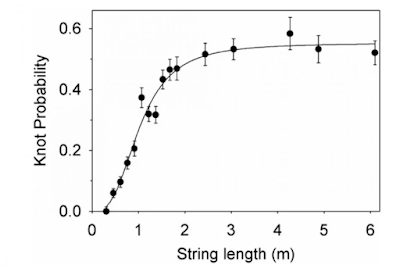One of the most annoying things with earbuds or any object, for that matter, with wires is how easily they get tangled, even if you neatly coil them before putting them away. Wires almost seem to have a life of their own. Well now physicists, Dorian Raymor and Douglas Smith, at the UC San Diego, explains how. Turns out tangling is "a function of the length of the wire and the amount of 'agitation' the wire is subjected to." Agitation here refers to the induced motion of a material in specified way. The pair published their findings in paper titled Spontaneous knotting of an agitated string. They find that a cord less than 46 cm (about 18 inches) "will almost never tangle itself when sealed inside a rotating box for a period." However, between 50 cm and 200 cm (1.5 to 6.5 feet), the probability of a knot forming rises dramatically. With a cord longer than that, the probability of a knot forming reaches a plateau of 50 percent." Here's what the probability curve looks like:
The article provides a helpful schematic showing how a coiled wire can quickly start to tangle in a rotating box. Rather inconveniently, one end of a cord only has to cross another part of the cord twice to begin spontaneously knotting itself:
So, it's basically a waste of time trying to organize your cords, physics says they'll likely find a way to tangle themselves. To paraphrase mathematician Ian Malcom: wires, uh...find a way.


.png)



Underground Dog Fence Training Tips
ReplyDeleteTraining your dog to use an underground fence Click here can seem daunting, but with the right approach, it
anything containing xylitol. Keep Discover Dog Training Strategies at K9Nerds.com harmful substances out of reach and educate your family about what’s safe for your dog.
ReplyDelete